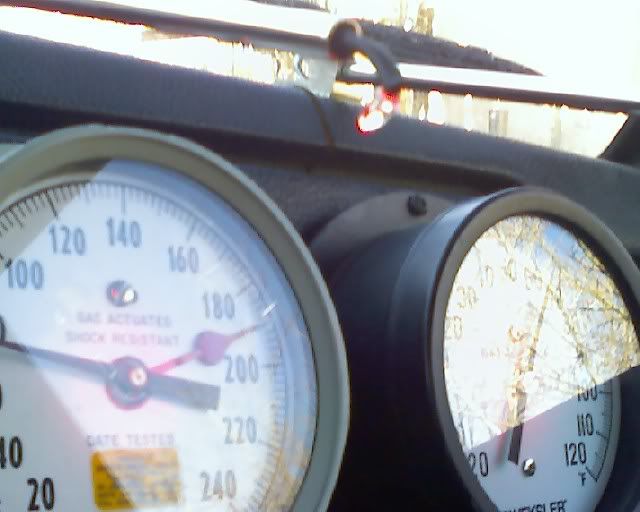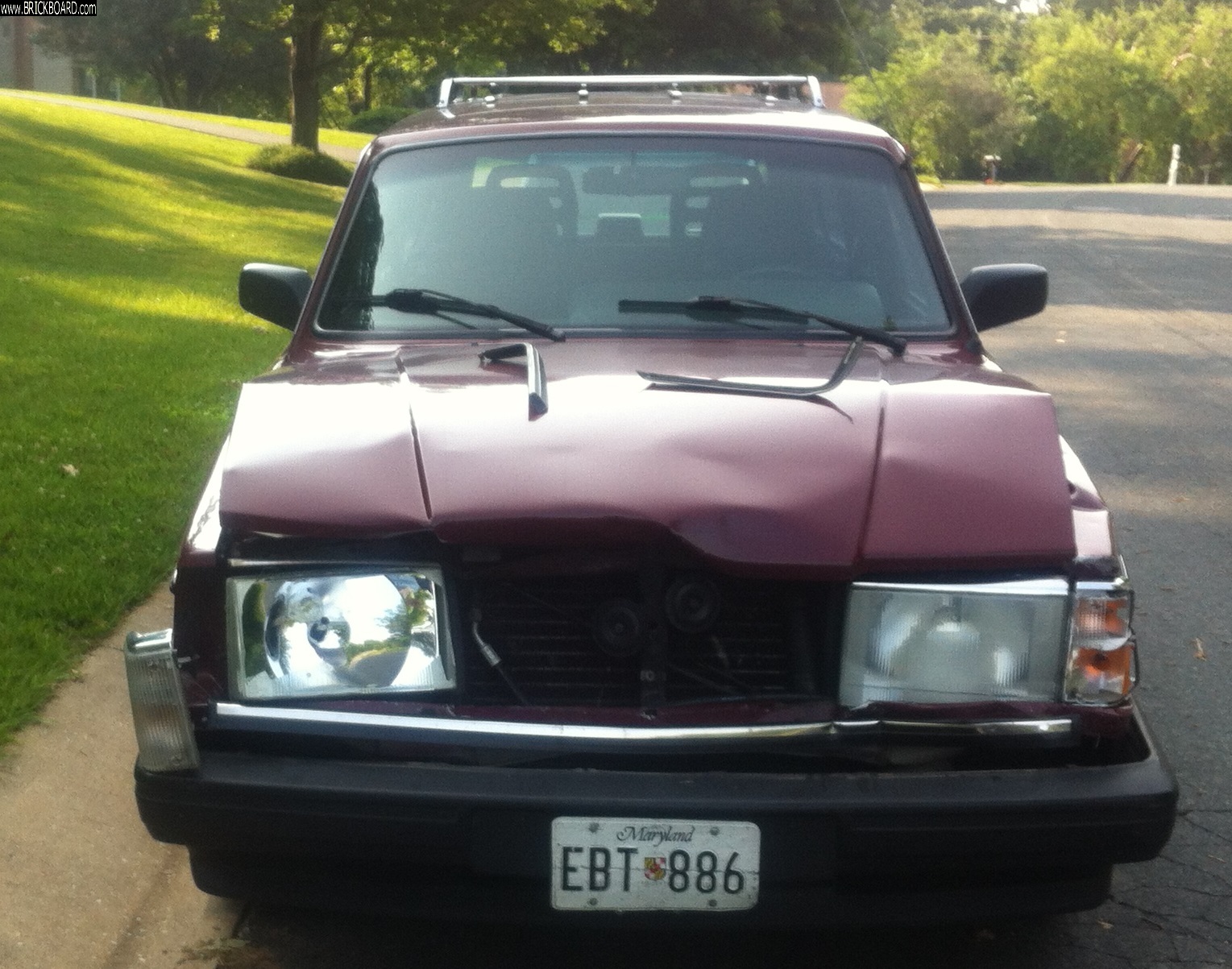
|
|
Hello,
If you’ve arrived here, you either want to change a wheel bearing, or have an itch to find out what this thread is all about. This thread is the first part of a two part post in which I will detail how to change a wheel bearing on a Volvo 240. The Volvo in the pictures is a 1977 264 GL, however the basic concept and design is similar for all Volvo 240’s. I hope you enjoy, and have fun!!!
1. The first step is to remove the wheel. When performing this operation, be sure that the car is properly supported with jackstands. Large blocks are not appropriate and can topple causing injury or damage to the vehicle. Once you remove the wheel, it should look something like this.
http://www.unm.edu/~goatman/bearing/nowheel.jpg
2. The next step is to remove the brake caliper mounting screws. There are two mounting screws which hold attach it to the strut tube. In my photo, I have replaced the hex head screws with Allen head screws which I prefer. The hex size is 17mm and for Allen screws, 10MM. It is always a sound idea to replace the brake caliper mounting bolts whenever they are removed. The size is M12x30mm.
http://www.unm.edu/~goatman/bearing/caliperremoval.jpg
3. Remove the brake caliper from the hub. The brake caliper will likely not slide off the rotor easily. This is because the brake pads have worn a ridge into the rotor and this restricts the caliper from sliding off. To slide the caliper away from the rotor, you must depress the pistons in the brake caliper to allow clearance between the pads and the rotor. For this I like to use larger Channellock slip joint pliers. You can find these at Home Depot and they really are a good investment. Grab the edge of the pad and squeeze the piston into the caliper.
http://www.unm.edu/~goatman/bearing/caliperpinch.jpg
4. Carefully remove the caliper from the hub taking care not to damage the copper brake lines.
http://www.unm.edu/~goatman/bearing/caliperunmounted.jpg
5. Remove the rotor retaining bolt. There is one, sometimes two pins or screws that hold the rotor onto the hub. Remove these with a 10mm wrench or socket.
http://www.unm.edu/~goatman/bearing/rotorbolt.jpg
6. Remove the brake rotor. The rotor should now be free from the hub, Although there is nothing retaining the brake rotor, corrosion forms between the hub and the rotor making removal difficult. Use a large dead-blow mallet to remove the rotor.
7. Remove the hubcap. Pry the cap away from the hub with a screwdriver. It helps to turn the hub and pry from opposite ends. Be sure not to damage the cap when you are removing it, It is made of soft steel.
8. Remove the castle nut retaining cotter pin. Using pliers, remove the cotter pin, It should be bent at the bottom to prevent the nut from loosening. Straighten the pin and pull it out the top.
9. Remove the castle nut. The size of the nut is 24mm or 15/16". I had a offset box wrench handy from my strut cartridge replacement that fit perfect. The nut should NOT be tight!!! Let me repeat that again, THE NUT SHOULD NOT BE TIGHT. The nut should be only installed enough to eliminate free play in the hub assembly. If the nut were tightened beyond that, the bearings would be quickly obliterated.
10, Lift off the hub assembly. I like to keep old metal pans around, they help keep things from being lost. Notice how I didn’t put the hubcap in the pan. That was a mistake, and now it could be lost.
http://www.unm.edu/~goatman/bearing/partspan.jpg
11. Clean the grease out of the hub. I sprayed mine out in the alley with the hose. Then I wiped it out with rags. Solvent causes brain damage.
http://www.unm.edu/~goatman/bearing/hub.jpg
12. Using a punch, drift the outer race out of the hub. Work the race out of the hub using even force. Don’t cock the race in the hub.
http://www.unm.edu/~goatman/bearing/punchouter.jpg
13. To remove the inner race requires supporting the casting in a fixture or vise. The outer race must have clearance to exit the rear of the hub.
http://www.unm.edu/~goatman/bearing/punchinner.jpg
Maybe if you found this helpful, you’d give a thumbs up?
Goatman
|
|
-
|
|
|
oh my, there are many scary steps. I remember in my college days of repacking the wheel bearings on my VW Beetle. Much easier than this. I will look at the photos and ponder this one. How difficult is this compared to replacing a timing belt....which i can do?
|
|
-

|
|
I haven't done this yet, but compared to the things that I have done, timing belt included, this will be a walk in the park!
Matt
|
|
-
|
|
|
Thanks, Goatman. I didn't see instruction #9, I tightened the castle nuts too tight while refurbishing the ABS sensors and replacing the reluctors, Now I'm buying new front bearing kits. Temp installing hubs w good bearings from my 88 245 onto this 92 245.
I should have reviewed my Bentley manual too, as well as FAQs in BB.
Anyone know the thread size in 240 front spindle? I have a metric threads file to clean up some burrs, but I'd prefer to chase the threads w a die.
TIA
|
|
-

|
|
Hi,
All of the links are broken because I graduated from UNM and they closed out my computing access.
All of the photos can be found here for the time being until I find a domain name.
http://80.255.6.46/bearing/
As far as the threads, they are pretty fine, and you may have to make do with a wire wheel on a drill / angle grinder.
Good luck!
|
|
-
|
|
|
I am going to do this on an 84 240. the bearing on the driver side is making noise at highway speeds. I am going to order the parts from fcp groton. I was wondering, do I need the whole bearing kit, or just one bearing? any clarification will be helpful- thanks!
|
|
-

|
|
Hello,
I’m glad you found the post. There are two bearings, inner and outer. You might have good luck at your local bearing distributor, if you live in a big enough city. Call around with the SKF bearing number. It should be stamped into the steel.
Also check this post:
http://www.brickboard.com/RWD/volvo/1448582/220/240/260/280/install_front_wheel_bearing_volvo_240.html
Goatman
|
|
-
|
|
|
Hi Goatman,
What's that green stuff on your brake bleeder valves? Thank you + Nice write up + Beautiful pictures + Thumb up.
|
|
-
|
|
|
Taking the liberty to put the pictures inline with his text:
If you’ve arrived here, you either want to change a wheel bearing, or have an itch to find out what this thread is all about. This thread is the first part of a two part post in which I will detail how to change a wheel bearing on a Volvo 240. The Volvo in the pictures is a 1977 264 GL, however the basic concept and design is similar for all Volvo 240’s. I hope you enjoy, and have fun!!!
1. The first step is to remove the wheel. When performing this operation, be sure that the car is properly supported with jackstands. Large blocks are not appropriate and can topple causing injury or damage to the vehicle. Once you remove the wheel, it should look something like this.

2. The next step is to remove the brake caliper mounting screws. There are two mounting screws which hold attach it to the strut tube. In my photo, I have replaced the hex head screws with Allen head screws which I prefer. The hex size is 17mm and for Allen screws, 10MM. It is always a sound idea to replace the brake caliper mounting bolts whenever they are removed. The size is M12x30mm.

3. Remove the brake caliper from the hub. The brake caliper will likely not slide off the rotor easily. This is because the brake pads have worn a ridge into the rotor and this restricts the caliper from sliding off. To slide the caliper away from the rotor, you must depress the pistons in the brake caliper to allow clearance between the pads and the rotor. For this I like to use larger Channellock slip joint pliers. You can find these at Home Depot and they really are a good investment. Grab the edge of the pad and squeeze the piston into the caliper.

4. Carefully remove the caliper from the hub taking care not to damage the copper brake lines.

5. Remove the rotor retaining bolt. There is one, sometimes two pins or screws that hold the rotor onto the hub. Remove these with a 10mm wrench or socket.

6. Remove the brake rotor. The rotor should now be free from the hub, Although there is nothing retaining the brake rotor, corrosion forms between the hub and the rotor making removal difficult. Use a large dead-blow mallet to remove the rotor.
7. Remove the hubcap. Pry the cap away from the hub with a screwdriver. It helps to turn the hub and pry from opposite ends. Be sure not to damage the cap when you are removing it, It is made of soft steel.
8. Remove the castle nut retaining cotter pin. Using pliers, remove the cotter pin, It should be bent at the bottom to prevent the nut from loosening. Straighten the pin and pull it out the top.
9. Remove the castle nut. The size of the nut is 24mm or 15/16". I had a offset box wrench handy from my strut cartridge replacement that fit perfect. The nut should NOT be tight!!! Let me repeat that again, THE NUT SHOULD NOT BE TIGHT. The nut should be only installed enough to eliminate free play in the hub assembly. If the nut were tightened beyond that, the bearings would be quickly obliterated.
10, Lift off the hub assembly. I like to keep old metal pans around, they help keep things from being lost. Notice how I didn’t put the hubcap in the pan. That was a mistake, and now it could be lost.

11. Clean the grease out of the hub. I sprayed mine out in the alley with the hose. Then I wiped it out with rags. Solvent causes brain damage.

12. Using a punch, drift the outer race out of the hub. Work the race out of the hub using even force. Don’t cock the race in the hub.

13. To remove the inner race requires supporting the casting in a fixture or vise. The outer race must have clearance to exit the rear of the hub.

Maybe if you found this helpful, you’d give a thumbs up?
Goatman
|
|
-
|
|
|
Thumbs up from me. Perfect timing, too. Doing the 245 Ti this weekend, parts are already in my tool chest. Had read about this in my Bentley but the pics are invaluable. Thanks for all of us. ---rick
|
|
-
|
|
|
Herewith, your thumbs-up.
--
Bob: son's 81-GL, dtr's '94-940, my 83-DL, 89-745(V8) and 98-S90. Also 77-MGB and some old motorcycles.
|
|
-
posted by
someone claiming to be Klus
on
Sun Oct 10 20:06 CST 2010 [ RELATED]
|
|
Nice pictures. Is that grey matter inside the hub MoS2 (Moly) grease? Why not use proper wheel bearing grease in there?
|
|
-

|
|
Klus,
The grease in there is from who knows what. The bearings are quite worn and were making noise, the new bearings are on order. Timken SET2 and SET6 (1975-1981 Model Year)
Goatman
|
|
|
|
|











